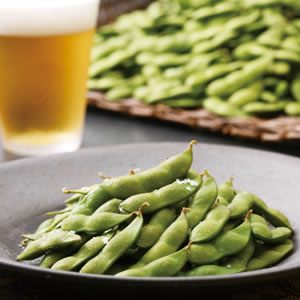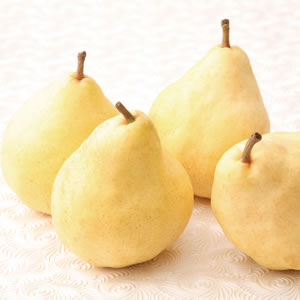Fish

Niigata is recognized as an important source of tasty fish. The melting snow that runs down the rivers in springtime is rich in nutrients, and encourages the growth of high-quality plankton the area’s two great rivers—the Shinano and the Agano. As these nutrients flow into the sea, they are consumed by local fish—and in particular, by small fish and white-fleshed fish. The many varieties of white-fleshed fish are highly prized for their excellent taste.
Koshihikari Rice

One of the country’s major rice producers, Niigata is an important grower of Japan’s most popular rice variety—Koshihikari. The nutrient-rich water that runs down the mountains as the winter snows melt, and the large shift in temperature between sowing and harvest, contribute significantly to the variety’s excellent taste and popularity.
Sake

Niigata’s famed sake acquires its distinctive qualities thanks to four factors: the area’s excellent water, its excellent rice, the expertise of master brewers, and a conducive climate. As winter snows melt, they generate cool underground flows that enhance the flavor of rice and provide high-quality drinking water. Slow low-temperature fermentation during winter months produces the crisp, dry texture and flavor that local sake is famous for. The city itself is home to 15 breweries. Why not visit some of the pubs in the area and compare the different sake varieties?
Niigata Sushi Zanmai Kiwami

Niigata is know both for its tasty rice and for the tasty fish taken year round from the Japan Sea. Squeeze the two together, and you have extra tasty sushi. The fatty kanburi (winter yellowtail) and melt-in-your-mouth nanban ebi (sweet shrimp), taken from the waters around Sado Island in winter, are especially well-known Niigata delicacies. The abundant local white-fleshed fish varieties are another great treat. Sushi shops are always ready to serve the best of the season, including standouts like blackthroat seaperch, yanagi-garei, and flounder. Many sushi establishments in the city—27 at last count—offer a special 10-piece kiwami (“the best”) platter (with bowl dish) that includes the chef’s selection of local seasonal offerings together with uni (sea urchin roe), toro (medium-fat tuna), and ikura (salmon roe).
Wappa Rice

A wappa is a distinctive round container fashioned of thin cedar strips; and meshi is rice. In days of old, wappa were used as lunch boxes. Wappa-meshi is rice cooked in thin stock, topped and then steamed in a wappa with local seasonal ingredients such as salmon, salmon roe, oysters, and chicken. Open the lid, and the fragrance rises up and stimulates the appetite. This special take on the seasoned-rice-with-toppings idea successfully enhances the presence of each ingredient, and brings out the full flavor of the underlying Koshihikari rice.
Hegi-Soba

In this dish, soba (noodles) are cooked with a bonding agent of funori seaweed and coiled into small ovals, and these ovals are then lined up in a wooden box called a hegi. The dish was invented in the city of Uonuma, in Niigata Prefecture, where funori was essential to the production of hemp fabric, the city’s main product. The seaweed bonding results in a soba that is smoother and chewier than standard noodles, making a better impression as it proceeds down your gullet. The seaweed is also responsible for the dish’s distinctive greenish tinge.
Niigata Tare-katsu Donburi

Katsu Donburi consists of fried, batter-coated pork cutlets on a bed of rice. In the rest of the country, the dish is topped with eggs; but within Niigata City, pork-cutlet specialty shops generally replace the egg with a locally concocted sweet-salty soy-based sauce (tare) that includes mirin (rice wine) and sugar. The dish was originated by the first-generation owners of the western-style Tonkatsu-Taro restaurant around 85 years ago (in the early Showa period), and gradually worked its way up to becoming a Niigata standard. This rather simple dish—just rice, sauce, and crunchy cutlet—might sound like a bore, but once you try it you may find it hard to put your chopsticks down. The thin coating is crisp and relatively greaseless, and the sauce goes very well with the rice.
Noppe

This traditional stew is one of the most prominent of Niigata’s local cuisines—an ever-present dish at festivals, New Year celebrations, family functions, and other such major events. Its many ingredients—which may include taro, konjac, carrot, lotus root, ginkgo nuts, salted salmon roe, shiitake mushrooms, and nameko mushrooms—are simmered in a thin soy-flavored stock. Each region—and perhaps each household—has its own particular recipe and cooking method, and the taste of familiar noppe is strongly associated with one’s home and family. Noppe may be served either warm or cold. The stickiness that emerges from the taro gives the sauce a thicker presence and helps bind it to the solid ingredients. You can try different versions of the dish at eating establishments of all sorts: restaurants, sushi shops, pubs, and other eateries.
Niigata Edamame (Soybeans)

One of the country’s main growers of edamame, Niigata Prefecture produces over 40 varieties. Edamame are in season from mid-June through early October. Perhaps the most well-known brand is Kurosaki Chamame, produced in the Kurosaki district of Niigata City’s Nishi Ward. Also called “the King of the Edamame,” the brand is known for its crunch, its sweetness, and its fragrance. Niigata residents can easily down a whole bowlful. Try them yourself—you can order them at most pubs in the area.
Mikazuki “Italian”

Niigata is home to a fast-food called “Italian” that originated in the 1960s at a coffee shop called Mikazuki. Although the dish resembles spaghetti, it is closer to yakisoba (fried noodles), with the noodles fried in sauce together with cabbage and bean sprouts, flavored with grated cheese, and topped with tomato sauce. At least 19 different eateries in the city offer this concoction. Interested visitors can easily find some on the second floor of the Bandai Bus Center, in the center of the city (in Chuo-ku).
Sasadango

Often given as a gift by Niigata residents, sasadango (sasa means bamboo leaves, and dango means dumpling) are made of mugwort-flavored sticky rice and red bean paste, wrapped in a few bamboo leaves, with each one then tied around with a few strands of rush grass. Unwrapping the leaves releases the aroma; and when you bite into the dumpling, its resilient texture and the sweetness of the red bean paste can speak to your heart. In the past, each household would prepare these dumplings in May for the annual Boy’s Day celebration, and also at rice-planting time. Various hypotheses have been offered as to the origin of sasadango; one suggestion is that the famed warlord Uesugi Kenshin carried these as preserved food when making his way to battle during the Warring States period (1467-1568). From that time to this, sasadango have remained a popular but very localized delicacy. Recent years have seen the emergence of cooking workshops where people can try their hand at making these dumplings. You can purchase sasadango at most department stores, and at gift shops at Niigata Station, Niigata Airport, Furusato Mura, and other locations.
Poppo-Yaki

These long thin pancake-like treats make an appearance at all Niigata holidays. They are made from a simple batter—based on weak flour and with the addition of brown sugar—cooked in long molds. They taste best if eaten immediately upon purchase. The springy texture and black-sugar taste expand in the mouth, and you soon find yourself reaching for another one. The “poppo” part of the name is said to derive from early efforts to attract the attention of potential patrons by placing a small whistle above the baking equipment, so that the rising steam would create a train-like “po po po po” sound. Poppo-yaki are sold from street stalls at many festivals—such as at the annual Kanbara Festival, held in Nagamine-machi (in Chuo-ku) from June 30 to July 2, and at the Hakusan Shrine festival. You can also purchase them at the Bandai Bus Center, and at numerous poppo-yaki specialty stores.
Echigohime Strawberries

In Niigata, when they think strawberries, they think Echigohime (Princess Echigo). The Niigata Agricultural Research Center developed this hybrid over the course of six years, and the resulting variety was named in honor of its youth, lusciousness, beauty, and local origin. These strawberries are characterized by a full aroma, a forceful sweetness, a shiny skin, and a pleasing acidic balance. They are relatively large, coming in at an average size of 20 grams (0.7 ounces). Inside the city, they are grown in both Minami-ku and Konan-ku. They are in season from late January through early June.
Le Lectier Pears

These pears, too, are grown in the Shirone district, the city’s “pear capital.” Local farmers brought the first Le Lectier trees over from France in 1903. Le Lectiers are considered a delicacy, as they are more difficult to cultivate than other western varieties and their yields are low. Happily, the area’s Le Lectiers are very tasty and of extremely high quality, thanks to the salubrious effects of the Shinanogawa River, which supplies abundant water and keeps the local land very fertile. These pears are known for their mellow fragrance and smooth texture, They are picked in late October, and are ready to eat by December after they soften and turn yellow.
